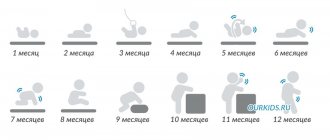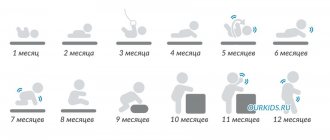Growth and development of a child at 9 months
In the ninth month of life, the baby gains 500 g of weight, the growth rate increases by 1.5 cm. Calculations of head and chest circumference become on average 0.5-1 cm larger.
Each child develops according to an individual schedule - both parents and pediatricians know this. But it is still necessary to focus on the average physical indicators of children of the same age, because this is how you can find out whether the baby has any errors in growth and what the pace of development of the child as a whole is.
The table below shows the main parameters of the physical development of 9-month-old children.
| Development parameters | Approximate normal values at 9 months | |
| girls | boys | |
| Height, cm | 68 – 73 | 70 – 76 |
| Weight, kg | 8,1 – 10,0 | 8,7 – 11,1 |
| Head circumference, cm | 45 | 46 |
| Chest circumference, cm | 44 | 45 |
Common problems
Having figured out what a child should be able to do at the age of 9 months, do not lose sight of the signs of problems that over time develop into quite serious ones. Let's look at the most common of them.
Refusal to try new foods. Under no circumstances should you force your baby to eat, but you should also not delay feeding. So experiment with different types of foods and offer them when your child is hungry. The cause of vagaries can also be excessively high air temperature.
Fear of strangers. This reaction is considered normal for babies at 9 months, they can turn away from strangers and cry, hide and reach out to their mother.
There is no need to insist on communicating with a stranger, convincing him that he is good; the baby will get used to it faster if new people remain neutral.
Fever and pain during teething. Special medical cooling gels and antipyretic drugs help solve this problem. Consult your doctor in advance so you don't have to look for a pharmacy in the middle of the night.
Basic skills: what a 9-month-old baby can do
A child in the ninth month of life stands confidently, leaning on the side of the crib, the wall or the hand of an adult.
If the baby feels sufficiently supported, he takes a few steps. The baby has not yet practiced walking independently and prefers to crawl to the desired location. By this age, a child masters the crawling skill with a bang - it can be difficult to keep up with a baby. Important! At 9 months, the period of attraction to objects at height begins, so parents should be especially vigilant and remove dangerous things that are slightly higher than the baby’s height.
So, what should a child at 9 months be able to do:
- Sit down independently from any position. A child can sit for 10-15 minutes without difficulty, while reaching for objects and pulling the desired toy towards him.
- The little fidget tries to climb onto low surfaces - sofas, chairs, armchairs, etc.
- Being near a support, he stands up independently and takes small steps. In baby walkers he squats, tries to jump, and moves tirelessly in them for up to 10 minutes.
- He actively uses the pinch grip in games. Tries to pick up small objects from the floor with two fingers.
- The child’s physical development also undergoes changes; the baby’s first milk teeth begin to appear (or continue to grow), sometimes several teeth erupt simultaneously.
- Speech is actively developing. The baby pronounces the cherished syllables “ma”, “pa”, “ba”. Gradually, the child’s speech includes new sounds and even short words (“on”, “where”, etc.).
- He holds objects in his hands tightly and confidently, but it is still difficult for a 9-month-old baby to unclench his fingers - he is fully aware of the entire “mechanism” of the process. Therefore, it can be extremely difficult to take away an object that he grabbed from a baby.
Developmental differences between boys and girls
Despite the fact that development in children of both sexes is almost identical, you can notice some features in the perception of the world, games, and behavior in girls and boys even at such an early age.
- Girls, regardless of temperament, show more interest in communication and emotions than boys. From infancy, the stronger sex is more interested in inanimate objects than people.
- Boys are often indifferent to sounds and voices than girls. That is why the vocabulary of women is replenished faster, which favors the early development of speech.
- Male children are better able to examine objects, play actively and develop spatial vision. Girls have more developed peripheral vision, and they will prefer attention and affection to toys.
Physiology of children at 1 year 9 months
The child’s body is growing stronger by leaps and bounds. Among the main indicators characteristic of a child aged 1 year 9 months:
- height – 80-91 centimeters for boys and 77-90 centimeters for girls;
- weight – from 10 to 15 kilograms for boys and 9-14 kilograms for girls;
- head circumference – 46-50 centimeters.
In addition to already fully developed motor functions, a child aged 1 year 9 months can freely step over obstacles, as well as walk on gymnastic benches raised from the surface, and accurately throw a ball into a basket.
Eating food no longer causes any difficulties for the child: without much loss, food of any consistency is skillfully put into the mouth.
Children love, and most importantly, know how to dress. Boys cope with T-shirts and T-shirts, and girls deftly put dresses over their heads. Unbuttoning, untying and taking off clothes and shoes is even easier and faster.
When a physiological need arises, children increasingly go to the potty themselves, knowing full well where the potty is geographically located, freeing parents from the obligation to run for this toilet item when necessary. Parents get control after a walk and after sleep; the rest of the time, children try to do it themselves.
Babies aged 1 year 9 months are very fond of gymnastic exercises, so for the development of the musculoskeletal system it is useful to do morning exercises. If a child has already been offered a place in a nursery, then he or she engages in physical education with his peers. If your baby is still being raised at home, you should include a warm-up in your morning exercise.
Don't forget to take your children for walks
Depending on the level of development, children aged 1 year 9 months already have up to 20 teeth in their mouths, which actively cope with solid food.
Neuropsychomotor development in the ninth month of life
The intellectual and motor development of a child at 9 months also gives parents many pleasant reasons to be proud of their baby. What new things can be noticed during this period?
- The baby has already managed to remember his name, and if he hears it, he reacts to it with a smile, turns towards the adult, and shows interest.
- The baby is able to express his emotions more vividly - when he is having fun, he rejoices and laughs; when angry, he shows resentment and even anger.
- Constantly points with his finger at different objects: those that he would like to touch (ask him to get something), and those he would like to climb into (please lift him to a high shelf, cabinet).
- Masters simple “yes” and “no” gestures. Reacts to requests from adults - “go to mommy”, “pick up the ball”, etc.
- He makes attempts to help his mother get dressed - he stretches out his arms, tries to insert his legs into his trouser leg. Pulls off his headdress on his own.
- Plays “hide and seek” with an adult, and can understand by voice or steps where the hiding parent is.
| Speech | The baby practices every day pronouncing entire chains of syllables. Many of them resemble the familiar words “mother” and “woman”. The child strives to imitate an adult, repeating those syllables that have already appeared in his babble - “pa-pa-pa”, “ma-ma-ma”, etc. |
| Hearing | With the help of auditory memory, he remembers and fulfills requests and verbal “instructions” - “kiss daddy”, “show mommy your pen”, etc. Can perform dance movements to a sound melody. |
| Vision | Observes what is happening around, pays attention to facial expressions and gestures of adults. Reacts to a smile, understands when mom is angry. |
| Emotions | Reacts violently (happily) to the appearance of mother in the room. Communicates with adults using simple gestures, pointing with a pen to an item of interest or showing dissatisfaction (waves his head). |
| Motor skills | Actively crawls, alternately moving the right and left pairs of limbs. At the support, he tries to immediately take a vertical position, standing on his legs. Stands confidently along the support and moves around, holding on with one hand. The child tries to grab small objects in the game with two or three fingers. |
| A game | The baby enjoys playing with several toys (objects) at the same time. During the game, he taps one cube against another. Prefers toys with musical accompaniment. If an adult hides a thing, the child will try to find it. |
Skills and abilities of a child at 9 months (video):
Intelligence and psychology of children by 21 months
By the age of 1 year 9 months, it is necessary to further develop the speech apparatus, and this happens at a rapid pace, the number of words reaches 30. Every day brings an addition to the children's vocabulary. Often, a child simply says what he overheard somewhere, so adults should pay attention to their speech and be careful when choosing their words. Not necessarily, but quite often, by the age of 1 year 9 months, children speak in simple sentences of several words.
The emotional state of children of this age, as a rule, is more associated with joy than with tears. By his mood, you can unmistakably determine whether the baby is happy or upset about something.
Bring joy to children
The development of color knowledge and the size of objects is progressing at a high rate - the baby already does all this without doubts or difficulties. Children begin to draw straight lines and circles. Particularly skillful ones show on their fingers that they will soon turn two.
Increasingly, a child of 1 year 9 months strives to communicate with other children, entering into cooperative relationships. Sociability becomes a striking feature at the age of 1 year 9 months; children make contact more easily with people they do not know.
Daily routine of a nine-month-old baby
- The average daily sleep requirement for nine-month-old babies is about 14 hours. The number of periods of daytime sleep should not be less than two, while daytime sleep (in general) is 4-4.5 hours, and night sleep accounts for 9-10 hours a day.
- Breastfed babies may also continue to wake up during the night and demand the breast. But this need in babies is not due to hunger, but to the need to be close to their mother.
- Often babies at this age have problems sleeping. The reason for this is overwork during the day, a failure in the established regime. Teach your child to get up and go to bed at the same time, and the baby will begin to sleep peacefully and gain strength at night.
A 9-month-old infant’s daily routine is not much different from the content of the regimen of the last month of life. Small changes can be observed in the table below, which presents a variant of the rational daily routine of a nine-month-old baby.
| Time (in hours) | Mode element |
| 7.00 | Waking up the child, hygiene procedures, gymnastics |
| 7.30 | Breakfast |
| 8.00 | Wakefulness, active games |
| 9.00 | Developmental activities, reading with mom, listening to music |
| 11.00 | Snack |
| 12.00 | Walk in the fresh air, first nap |
| 14.30 | Dinner |
| 15.00 | Wakefulness, games, educational activities, massage |
| 16.00 | Walk in the fresh air, second nap |
| 18.30 | Snack |
| 19.00 | Staying awake, reading with mom, quiet games |
| 20.00 | Dinner |
| 21.30 | Evening bathing, getting ready for bed |
| 22.00 | Snack, bedtime |
Caring for a 9 month old baby
Care for a nine-month-old baby is based on the same techniques that were carried out by adults in all previous months, starting from the moment of birth. These are the three main components:
- hygiene procedures (washing, rinsing, evening bathing);
- light gymnastics;
- massage.
On a note! All care procedures should, if possible, be carried out at the same hours - this is how the child can gradually be accustomed to the daily routine and his routine can be established.
Bathing a baby at 9 months
The procedure for taking a bath at this age is usually already established by parents, and the baby enjoys spending time in the water. If a child likes to swim, then you can let him “splash” for 20-30 minutes, getting the baby interested in water fun: soap bubbles, boats, balls, rubber animals with sprinklers and cups for pouring liquid.
Advice! Children, as a rule, are already sitting well by nine months, so you can purchase a special high chair or circle for the bath. Such objects will provide a stable position and prevent accidental falls.
Massage at 9 months
Strengthening muscles at this stage of development is simply necessary - thanks to massage procedures, the baby improves the skill of crawling and prepares to master walking. The mother can perform the massage herself. You just need to remember a few basic points and techniques:
- The first massage sessions last no more than 10 minutes. The child should be calm and in a good mood. To relax, you can turn on calm melodic music;
- You need to start the procedure with soft stroking with your palms of the baby’s body parts - arms, legs, back and tummy. Hands are massaged from palm to shoulder, legs also from foot to hips;
- The tummy is massaged clockwise with light movements. When massaging your back, it is worth remembering that the spine does not need to be affected by the massage. The baby's back is massaged up/down along it, as well as towards the sides;
- It is especially important to spend time on the baby’s palms and soles, massaging each finger separately, this promotes the development of fine motor skills;
- The massage ends with gentle, almost weightless pats.
Gymnastics at 9 months
Exercise for a nine-month-old baby is an integral part of morning routine. It is performed before breakfast, in the first 10 minutes after waking up and is of a general strengthening nature for the child’s health.
This is what a set of gymnastic exercises for “beginners” looks like:
- we warm up the muscles of the arms and forearms: the child lies on his back, the adult bends and straightens the baby’s arms at the elbow joints, alternates with crossing them, then makes circular movements;
- we warm up the leg muscles: an adult alternately bends the child’s legs at the knees, imitating riding a bicycle, then bends and straightens the legs at the same time;
- turns are performed in both directions from the back to the tummy and back;
- sitting down and lifting the child’s body by straightened arms;
- crawling after an object/toy;
- rocking movements on a fitball in different body positions - lying on your stomach and lying on your back.
Baby care
The care procedures remain the same, but emotionally proceed differently, because the baby imagines how bathing, washing, massage or eating is carried out. The baby gets involved in these processes and is happy if they praise him when something has worked out. There is no need to suppress initiative - the baby must develop independently. If the baby can’t cope, you don’t need to do anything for him. In this case, it is recommended to empathize, showing only positive emotions. In general, baby care includes activities for:
- Proper and regular hygiene. From childhood, you need to teach your baby to take care of himself.
- Normalization of sleep. It ensures normal mental and physical development of the child at 9 months.
- Creating a child's menu. At 9 months, breast milk already makes up only 1/4 of the diet. Feeding your baby should include certain foods.
Hygiene
Daily routines include washing, scrubbing, bathing, cleaning the mouth and ears, brushing, pottying, and sometimes cutting nails. For your teeth, you should buy a rubber brush. You need to clean them morning and evening. From this age you can begin more active hardening:
- start with a water temperature of 30 degrees;
- lower it by 1 degree every day until it reaches 20;
- after getting used to it, you can carry out contrast procedures by first pouring water at 36 degrees, and then immediately at 20 degrees.
9 month old baby's sleep
A 9-month-old child sleeps 12-14 hours a day, 10 of which are nighttime sleep, and 1.5-2 hours twice a day - during the day. At night, the baby wakes up 1-2 times to feed, although it can do without waking up. This is the baby's normal routine. While awake, you need to work with the baby, taking into account the mood and time of day. In the morning it can be gymnastics and active games; looking at pictures is left for the evening before bed.
Feeding
A nine-month-old baby is still a baby, but mother's milk is no longer the only source of nutrition. There should be at least 5 meals a day with breaks of 3.5-4 hours. They should occur at approximately the same time. The baby is fed breast milk in the morning, before naps, at night, before bed and sometimes at night. Infants receive complementary feeding in the amount of 1000-1200 ml of adult food throughout the day, i.e. 200-240 ml at a time. In between meals, you can give a drink - compote or unsweetened tea. Baby food may include:
- meat;
- fish;
- dairy products;
- fruits;
- vegetables;
- baby cereals and purees.
Sample menu for a 9 month old baby
By nine months, the baby’s digestive system is already quite strong. The first feeding is over, the baby has grown to the point where it is time to appreciate the variety of new tastes and their combinations in food products. The volume and quantity of enzymes produced for breaking down food increase with each week of life, and along with them, the body's immune defense mechanisms work better.
This is what a sample menu looks like for a baby in the ninth month of life:
| Eating | What do we eat |
| Breakfast | 90 g porridge, 60 g chopped fruit, 100-120 ml breast milk/formula |
| Snack | 100-150 ml fruit juice, 50 g boiled vegetable puree or diced cheese |
| Dinner | 60-90 g of meat puree, or yogurt or low-fat cottage cheese, 100 g of vegetable puree, 100-150 ml of breast milk/formula |
| Snack | 100 g finely chopped fruit or baby yoghurt, 1 baby biscuit |
| Dinner | 60-70 g of boiled meat in puree, 60 g of vegetable puree or rice, half of chopped fruit, 100-150 ml of breast milk/formula |
| Snack (before bed) | 150-200 ml kefir or breast milk/formula |
Important! The number of “milk” feedings is gradually reduced. In the 9th month of life, breastfed children receive mother's milk 3-4 times a day, and bottle-fed babies need 2-3 servings of formula per day.
What are we eating?
The table lists the main products that make up a child’s diet at a given period of life.
| Product | Serving Size |
| Kefir, baby yogurt, milk (for cooking porridge) | 150-200 ml per day |
| Meat purees (beef, pork, turkey, rabbit) | up to 50 g per day |
| Fish (cod, hake, haddock, salmon, pollock, trout) | We start giving it with 1 tsp, and over 2-3 meals we bring it to a serving of 50 g/day. Up to a year, give fish no more than 1-2 times a week. |
| Vegetables (broccoli, cauliflower, zucchini, potatoes, carrots, beets, pumpkin) and cereals (rice, buckwheat, corn, wheat, barley) | up to 180 ml per day |
| Fruit juices and purees (apple, pear, peach, apricot, plum) | 80-90 ml per day |
| Low-fat cottage cheese (no more than 3%) | no more than 40 g per day |
| Yolk | 20-30 g per day |
| Children's cookies, crackers | 5 g |
Delicious and healthy recipes for your baby
The diet of a nine-month-old baby includes up to 5-6 feedings per day, including snacks. Try to diversify your child's daily menu. Remember that properly prepared complementary foods are a source of nutrients for young children. Don't know what to cook for a tiny gourmet? We offer you several recipes for a complete children's meal.
Potato and zucchini salad
Wash and peel 2 medium sized potatoes. Cut the vegetable into small cubes, place in a small saucepan and fill it with water to half the volume. Peel half the zucchini, cut into pieces and add to the potatoes. Place the pan over medium heat and bring to a boil. After 5-7 minutes of boiling, drain the water, mash the vegetables and cool to room temperature. Add 1 tsp. vegetable oil (preferably olive oil).
Cod fillet with rice
Boil 1 liter of water in a saucepan. Add 1.5 tbsp to boiling water. rice and a small part (no more than 4-5 cm) of a peeled leek. Cook over low heat. After 15 minutes, add 30 g of chilled cod fillet to the pan. Cook for another 7 minutes, then remove from heat and pour the broth into a separate container. Mix rice with leeks and cod, add 2-3 tbsp. broth and season the dish with a couple of drops of olive oil.
Oatmeal with milk and peach
Wash 1 ripe peach, peel and chop using a coarse grater. Boil 100 ml of milk (fat content no more than 2.5%). Pour 1 tbsp into the boiling milk in a thin stream. oatmeal intended for cooking. Add grated peach. Simmer over low heat for 3-5 minutes, then remove from heat and cool until comfortable (porridge should be served warm).
Helping a 9-month-old baby develop
Babies at nine months spend a lot of time in their mother's arms. It is not easy to carry a baby for many hours a day, but before walking, the child needs to be “tame” - oddly enough, this is one of the stages of proper mental development.
We suggest paying attention to several important tips that will help to comprehensively develop a nine-month-old baby in a playful way.
Develop your speech
In order for your baby to accumulate a passive vocabulary, you need to talk to him daily and a lot. Don't know what to talk about with your baby? You can start by commenting on what is happening. “Mashenka will now get dressed and go for a walk with her mother,” “today Mashenka will eat porridge,” etc. Read books with nursery rhymes, memorable fairy tales, and poems in which words are repeated to your child.
Teach your baby to crawl
There are babies who, for one reason or another, do not show the desire to crawl, although they are completely healthy. Parents should make every effort to teach their child to crawl, this is an important step towards the subsequent development of walking. When trying to crawl, provide alternate support for its legs - this way, with your help, the baby will learn the technique of “cross” crawling.
Stimulate fine motor skills
Do a warm-up for your fingers every day. Let your child crumple and tear the paper, show how to crumple it. Have a sensory box with pieces of objects of different textures and materials (as long as they are safe!). Let the baby get acquainted with new tactile sensations (a sponge is soft, a bottle cap is hard, etc.).
Encourage physical activity
Does your child like to crawl and explore everything around? Don't put him in the playpen for a long time. An excellent solution could be a folding house with a tunnel. The baby will be happy to crawl into the house through the tunnel and back. You can bring this kind of entertainment to life without spending extra money by making a little house out of cardboard boxes.
Developmental activities for a 9 month old baby:
How to develop speech skills?
In children aged nine months, speech develops intensively. Some babies' babbling becomes more conscious. Seeing his mother or grandmother, the baby begins to say “ma-ma, ma-ma” or “ba-ba, ba-ba.” Of course, this applies to those children with whom parents are actively involved.
It is necessary to encourage the child to babble. The mother is recommended to communicate a lot with the baby, using simple words in her speech. It is useful to use “mama”, “dad”, “baba” more often.
You can replenish your passive vocabulary using the following methods:
- show pictures with images of natural phenomena, vegetables, fruits, animals, saying what is drawn on them;
- read fairy tales, poems to the baby, sing children's songs;
- Mom and dad need to comment on all their actions regarding the child. It is desirable that the speech be emotionally charged.










